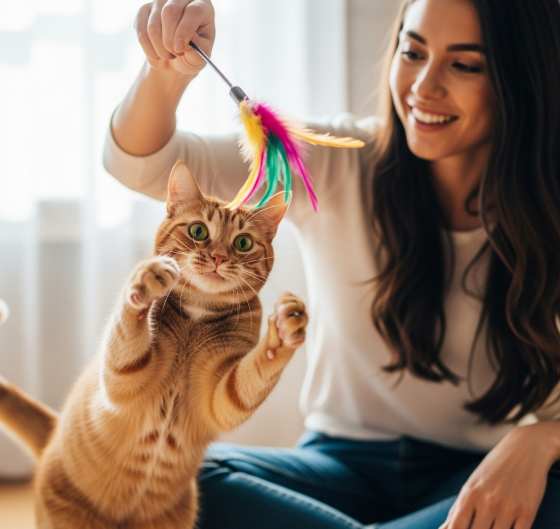“Keeping your cat mentally and physically active is essential for their well-being.”

Yes, cats need regular exercise just like we do! A sedentary lifestyle can negatively affect both their physical and mental health. But how much exercise does your cat truly need? That depends on several factors, including age, breed, and personality.
Here’s a helpful guide to ensure your cat stays active, healthy, and happy—whether you live in a small apartment or have a curious outdoor explorer.
How Much Exercise Do Cats Need Each Day?
Most kittens are little bundles of energy, often needing over an hour of daily play to burn off steam. For adult cats, about 30 minutes of exercise per day is typically enough to keep them fit and stimulated. However, this can vary based on the cat’s lifestyle and temperament.
Outdoor cats often get plenty of movement from exploring, climbing, and “hunting,” but indoor cats may need a bit more encouragement and creativity to stay active.
Why Regular Exercise Is Important for Cats
Daily exercise isn’t just about keeping your cat slim—though it does help! It supports both physical and mental well-being, and can even prevent behavioral issues.
Physical Health Benefits
- Maintains a healthy weight, helping reduce the risk of obesity-related issues like diabetes and joint pain
- Builds and maintains muscle strength, which is especially important for senior cats
- Improves mobility and coordination, keeping your cat agile and playful
Mental Health Benefits
- Prevents boredom, anxiety, and depression by providing necessary mental stimulation
- Reduces unwanted behaviors like scratching furniture or urinating outside the litter box
- Strengthens the human-animal bond through shared playtime and interaction
Fun and Easy Ways to Exercise Your Cat
The best type of exercise for your cat is the one they enjoy most! Some cats are independent players, while others love interactive sessions with their humans. Here are some engaging ideas to try:
1. Interactive Toys
Toys like treat-dispensing puzzles, laser pointers, or battery-powered mice are great for stimulating solo play. Food-motivated cats especially love toys that reward them with a tasty bite. Just be sure to use healthy, vet-approved treats.
2. Wand and Teaser Toys
Wand toys mimic prey and encourage your cat’s natural hunting instincts. These are perfect for bonding and allow you to control the pace and type of movement, making them ideal for cats of all ages.
3. Cat Trees & Climbing Towers
Cat trees give indoor cats a taste of adventure. They encourage climbing, stretching, and lounging—plus, they’re a great way for multi-cat households to socialize.
4. Scratching Posts & Mats
Scratching might look simple, but it’s a full-body stretch for your cat and helps keep claws healthy. Think of it as feline yoga!
5. Cat Exercise Wheels
If you’ve got the space and a high-energy cat, an exercise wheel can be a fun and effective option. Always choose high-quality wheels from trusted brands for safety.
Tip: Your cat’s favorite window perch can also be a launchpad for play! Initiate movement when they’re naturally alert, especially at dawn or dusk—cats are crepuscular and most active during those hours.
Can Other Pets Help Keep Your Cat Active?
While a fellow pet can make a great playmate, especially in multi-animal households, it’s not a replacement for one-on-one play and proper enrichment. Every cat still needs individual attention and tailored toys or gear that suits their personality.
FAQs: Cat Exercise & Activity
Do Indoor Cats Need Daily Walks?
Leash training your cat is a great way to add exercise and mental enrichment, but it’s not required for every cat. If your feline enjoys the outdoors safely, walks can be a fantastic routine.
How Can I Tell If My Cat Isn’t Getting Enough Exercise?
Look for signs like weight gain, muscle loss, or destructive behavior (e.g., clawing furniture, inappropriate urination). These may point to boredom or inactivity. Consult your vet if you’re concerned about changes in your cat’s health or habits.
What If My Cat Isn’t Interested in Playing?
Some cats are naturally less playful, but a lack of interest in play can also be a sign of pain, such as arthritis. Try a variety of toys or food-based puzzles to spark curiosity. If your cat still isn’t engaging, schedule a check-up—cats are experts at hiding discomfort.
Final Thoughts
Helping your cat stay active doesn’t have to be complicated. A mix of play, enrichment, and bonding time can go a long way in supporting their physical and emotional health.
Whether your cat is a wild kitten or a chill senior, staying active is key to a longer, happier life. For specific concerns or tailored activity plans, don’t hesitate to talk to your vet—they know your cat best.
